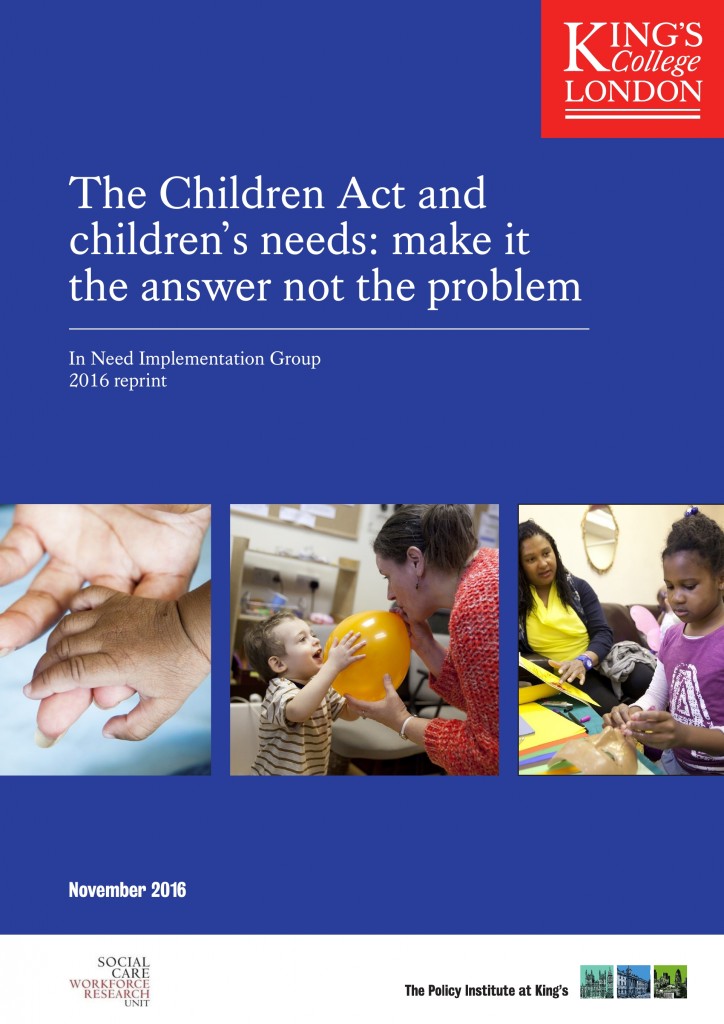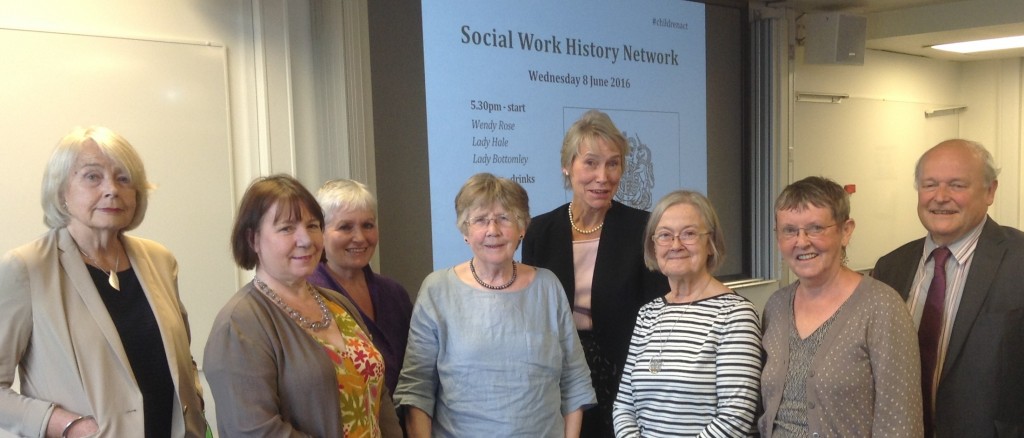 The Policy Institute at King’s and the Social Care Workforce Research Unit have reproduced a 1991 report into the implementation of the Children Act 1989, and updated it with a new foreword and introduction, the latter by Jane Tunstill, who here discusses current legislative proposals. (1,408 words)
The Policy Institute at King’s and the Social Care Workforce Research Unit have reproduced a 1991 report into the implementation of the Children Act 1989, and updated it with a new foreword and introduction, the latter by Jane Tunstill, who here discusses current legislative proposals. (1,408 words)
It is no coincidence that the longest-running play on the London stage, The Mousetrap, which is still being shown after 64 years, is based on a key tragic event in the history of childcare policy in this country. Agatha Christie recognised that the death of Dennis O’Neill in 1945, at the hands of his foster parents, was a topic to engage the attention of her readers, and audiences have certainly proved her right. The tragedy, and subsequent enquiry, directly triggered the Children Act 1948, which introduced a national framework of children’s departments responsible for the systematic oversight of the welfare of children.
The recent release of Ken Loach’s new film, I, Daniel Blake, has reminded commentators of the popular feeling aroused by his 1965 film, Cathy Come Home. The image of children being taken forcibly from their homeless parents by social workers had a powerful impact on attitudes and national child care policy. Indeed, the British Association of Social Workers (BASW) issued guidance in 1971 that no social worker should receive a child into care because of homelessness alone. The 2013 film Philomena attracted huge popular acclaim for its portrayal of the Roman Catholic Church’s forced adoption of the babies of single mothers, and 2016 saw a papal apology for the practice.
None of this should surprise. Few topics are more emotive than the relationship between children, their parents and the state, a fact reflected in the public reaction to such theatrical or cinematic interpretations. Each of the three stories explores the same debate as to when the state has a duty to provide support to parents to rear their children; the degree to which the absence of such support justifies forcible removal of children from their parents; and whether the action taken by the state is always helpful.
Of course, it is at the legislative level that these questions are addressed and resolved, at least within a democratic system. The social history of child care in England reflects a largely progressive trajectory through the centuries, from the offer of a place in the local workhouse (Poor Law Amendment Act 1834), through a duty to prevent reception into care (Children and Young Persons Act 1963), to a duty to safeguard and promote the welfare of children in need (Children Act 1989). Laissez-faire attitudes have been slowly mediated by growing, evidence-based awareness of the importance of a child’s birth family to her or his welfare and development. The 1989 Act had all-party support for its balancing of participatory rights for parents and children with children’s rights to protection. While outcomes for children who cannot live with their families still need to be greatly improved, it has been admired at both the international and national level: indeed some of those who worked behind the scenes to draw up and implement the 1989 Act also contributed to the formulation of the UN Convention on the Rights of The Child.
 Post author, Jane Tunstill, is pictured (left) with (l-r): Jill Manthorpe, Wendy Rose, June Thoburn, Lady Bottomley, Lady Hale, Jo Tunnard and Terry Bamford at the Social Work History Network meeting at King’s in June 2016, which marked the 25th anniversary of the Children Act 1989 coming into force.
Post author, Jane Tunstill, is pictured (left) with (l-r): Jill Manthorpe, Wendy Rose, June Thoburn, Lady Bottomley, Lady Hale, Jo Tunnard and Terry Bamford at the Social Work History Network meeting at King’s in June 2016, which marked the 25th anniversary of the Children Act 1989 coming into force.
In 2016, the Children Act 1989 remains a highly respected piece of legislation, admired for having brought together in one Act both public and private law, for its sensitive engagement with the most fundamental tensions in child and family life and for its support for a progressive model of social work. Its clauses can be accurately described as evidence-based, its drafters having drawn on extensive empirical knowledge. Such empirical commitment was maintained after the Bill was passed, with government commissioning a successive wide body of research to support its implementation and evaluate its outcomes for children. Moreover, throughout its passage through Parliament, politicians and civil servants maintained an open and respectful culture of engagement and consultation with families, providers and the social work profession across the statutory and voluntary child care sector.
However, disappointment has been expressed about the implementation of the Act, especially in respect of the children in need clauses, intended to support the welfare of children in their birth families. There was and is widespread agreement across the child care sector that these clauses should be taken seriously. In reality, the laudable preventative intentions of the Act have been eroded by a combination of inadequate funding and the emergence of a risk-based approach, whereby adversarial care proceedings have replaced the partnership work with parents that was envisaged by the architects of the Act. A shift in social policy approaches since 2010 has encouraged a re-emergence of the 1834 Poor Law concept of deserving and undeserving poor, and a reluctance to support poor parents, nowhere more clearly expressed than in the emphasis on adoption, with or without the consent of parents.
But in spite of deficits which can be identified in the implementation of the 1989 Act, as a piece of legislation, it still stands in stark contrast to the shape of current government proposals, laid out in the Children and Social Work Bill, which is before Parliament at the time of writing. In the absence of consultation—neither a Green nor White Paper—and in the face of robust opposition from 43 organisations across the sector.
Clause 29 of the current Bill proposes a fast-track process for area-by-area derogation and modification of children’s social care legislation. Deregulation could last for up to six years. In my view its support for a return to local variation—reminiscent of the Poor Law, with any support then dependent on where you lived—takes children’s legislation backwards to the 19th century. Exempting a local authority from a statutory duty (such as the Children Act 1989 section 17 duty to safeguard and promote the welfare of children in their area who are in need) seems set to facilitate arbitrary and unjustifiable distinctions between the treatment of similar children who happen to live in different places. Similar dilution and fragmentation would also apply to the section 20 duty to accommodate a child in need, and the duty to investigate whether action is necessary to safeguard or promote the child’s welfare under section 47. Arbitrary distinctions may violate the prohibition of discrimination in the European Convention on Human Rights and the UN Convention on the Rights of the Child.
These ‘exemption’ clauses sit alongside the government’s intention to create a ‘market’ for children’s services, following publication in July 2016 of a document stating its ambition that more than a third of children’s social care services will be run outside councils by 2020. It is not clear whether exemptions from legal duties will help make this happen. In 2014, the government commissioned Laing & Buisson (a leading healthcare market intelligence provider) to consider different options for how children’s social care services could be run, including for-profit, charitable purposes, and by the state. The company’s report on children’s social care, paid for by the taxpayer, has never been published and successive Freedom of Information requests have been refused.
The government suffered a defeat in the House of Lords over clause 29 on 8 November 2016: the crossbencher Lord Ramsbotham successfully moving an amendment to delete it and, for the moment, withhold from ministers extensive powers to sidestep children’s legal rights built up over decades.
Peers rejected the government’s argument that council social services departments were over-regulated and that proposed powers in clause 29 of the Bill would free them to drive ‘innovation’ in social work practice and make services more efficient. Peers voted 245-213 in favour of an amendment to scrap the clause in its entirety but there is no certainty the government will not try to re-insert it when the Bill moves to the House of Commons.
Vigilance must still be maintained in respect of this Bill, and the evidence must continue to be presented. In my view, the Bill’s proposed developments, if realised, pose a very serious threat to the shape of child and family services in this country. The values which underpinned the Children Act 1989 are under serious challenge by these proposals, and without public or professional agreement, the existing framework of services for vulnerable children and their families may be altered beyond recognition. If Mousetrap audiences at the theatre have shivered in apprehension, and Philomena audiences at the cinema been appalled by its portrayal of relatively recent cruelties, this is a moment to raise their voices. After all, 1989 was a better year than 1834 to be a child in need (of course it is better not to be in need at all)—in 2016 politicians must ensure that the legislation they pass will improve the lives of children, not make them worse.
This post was written by Professor Jane Tunstill, a member of the Social Care Workforce Research Unit and Emeritus Professor at Royal Holloway, University of London, who has written, researched and taught extensively on child welfare and social work. Professor Tunstill was part of the team that produced a 1991 report into the implementation of the Children Act 1989:
In need implementation group (2016 reprint of 1991 pamphlet, with a new foreword and introduction) ‘The Children Act and children’s needs: make it the answer not the problem’, London: Social Care Workforce Research Unit, Policy Institute at King’s College London.
The Social Work History Network held a special event on the Children Act 1989 in June 2016.
This post first appeared on the Policy Wonkers blog of the Policy Institute at King’s.